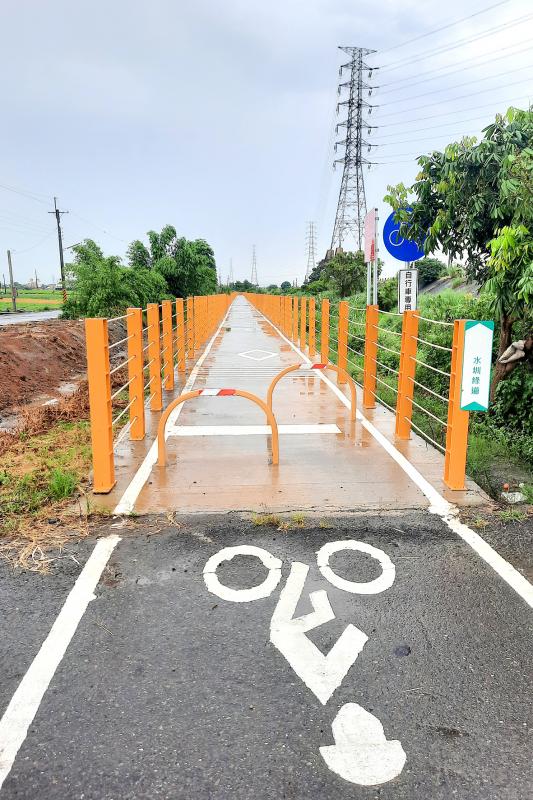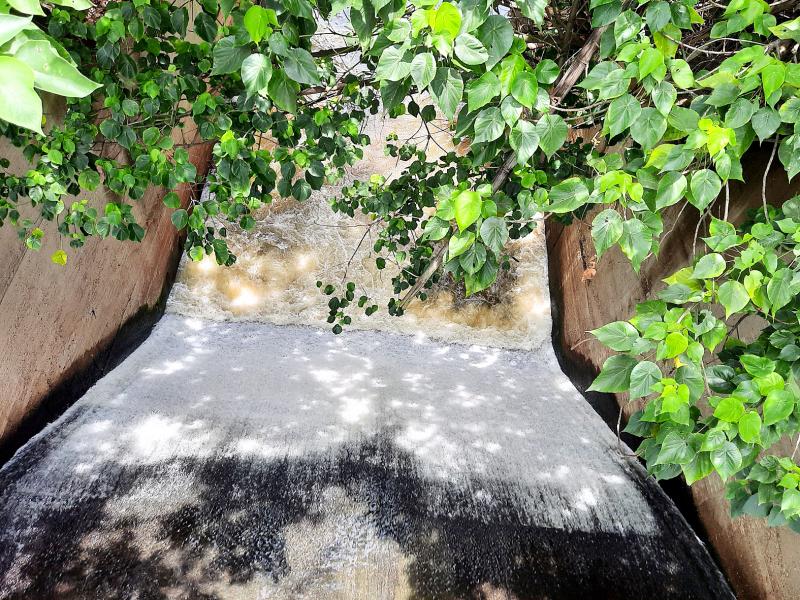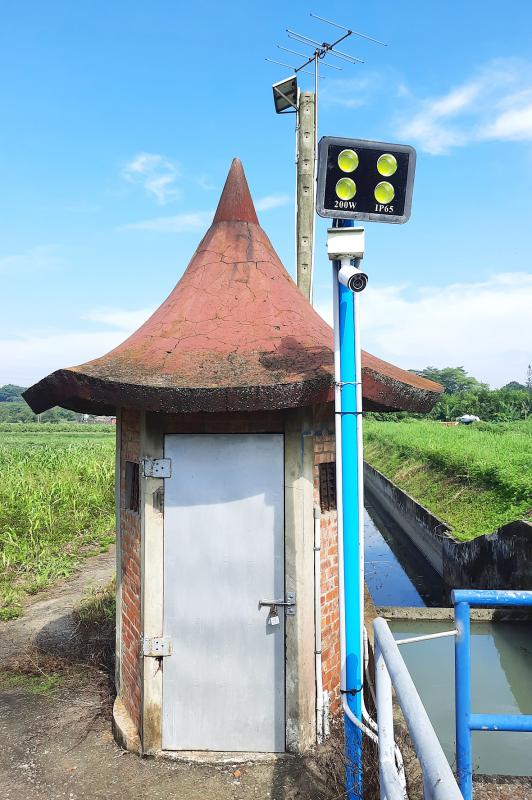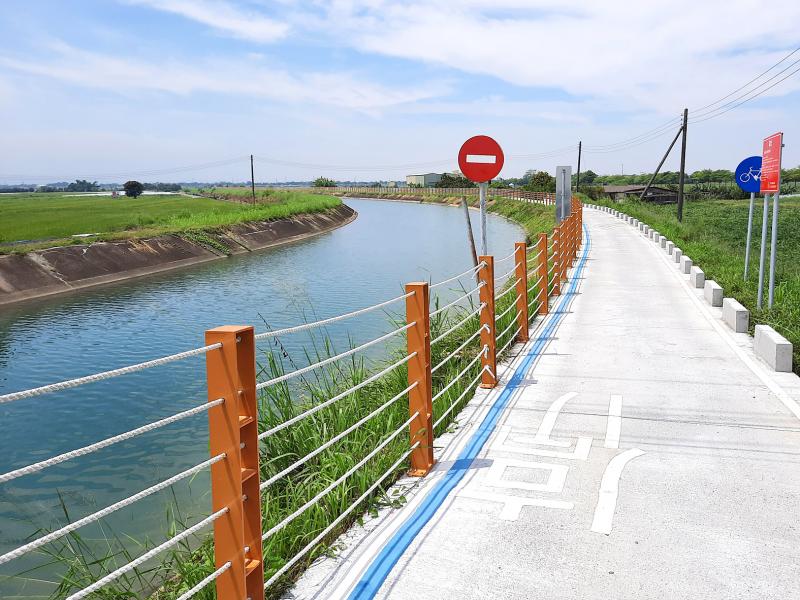With some fanfare — and a bit of skepticism among the cycling public — on March 12 this year President Tsai Ing-wen (蔡英文), Premier Su Tseng-chang (蘇貞昌) and Council of Agriculture Minister Chen Chi-chung (陳吉仲) inaugurated what’s being described as the country’s longest bikeway.
Boasting a total length of 87.5km (according to English-language reports) or 88km (the figure given by Chinese-language media), the cycling route connects Tainan City, Chiayi County and Yunlin County.
As soon as I heard about this bikeway, I knew I’d give it a try. I also realized that doing so as soon as possible — before the weather got uncomfortably hot or wet — made sense.

Photo: Steven Crook
So I did what I’m good at. I procrastinated. Flimsy excuses reinforced legitimate reasons. It wasn’t until early one morning late last month that I launched my unsuccessful yet oddly satisfying first attempt to cycle the entire thing.
To get to the southern end of the new trail, I rode along quiet country roads, a section of Provincial Highway 1 and a stretch of the cyclist-friendly Mountains to Sea National Greenway (山海圳國家級綠道). I’ve described part of this older greenway in a previous article (“Lakeside to seaside, by bike and car,” in the July 16, 2021 Taipei Times).
Finding the actual starting point of the new bicycle path, the official name of which is the Canal Greenway (水圳綠道), was a little tricky. Its southern end, I now know, dovetails with the Mountains to Sea National Greenway at the Chianan Irrigation Association (嘉南農田水利會) substation in Wushantou Borough (烏山頭里) in Guantian District (官田).

Photo: Steven Crook
There’s no English-language sign or mapboard there (or, for that matter, anywhere else along the Canal Greenway). However, the blue-and-white Chinese signs that have been stenciled every few hundred meters on the surface of the trail are obvious enough.
The cycling route initially follows the eastern embankment of the Chianan irrigation system’s major north-south watercourse, but soon switches over to the west side. I’d not gone far at all before I realized that while this landscape was highly familiar — I’ve traveled countless times between Tainan and Chiayi by train, car, bus, motorcycle and bicycle — I was seeing it all from a fresh angle.
Around 3.6 km from the starting point, I stopped to take a photograph of an unusual steeple-roofed sentry box. Near the km17 marker, I came across two more of these oddities.

Photo: Steven Crook
After passing the km10 marker, I noticed that the fencing alongside the greenway hadn’t been finished. A few hundred meters further along, I came across construction work, then a 206m-long metal aqueduct.
It appears to be a sturdy structure, yet its height and narrowness makes crossing Gueijhong Creek (龜重溪) an unnerving experience. On the north bank, I pushed through deep mud, negotiated a shoulder-high barrier, cleaned my tires then pedaled on.
THE NEED FOR TREES

Photo: Steven Crook
The government has promised to plant 100,000 trees along the Canal Greenway, to provide much-needed shade, but I didn’t see any new trees until I reached Dongshan District (東山). As I cycled, I startled dozens of skinks and other lizards basking on the exposed concrete bikeway.
More than three quarters of the Tainan section of the Canal Greenway, I’d estimate, was purpose built for cyclists. Only in a few places do bikes have to share the thoroughfare with faster vehicles. Several long stretches of bikeway have replaced levee-top maintenance roads. In both Tainan’s Houbi District (後壁) and Chiayi County’s Shueishang Township (水上), the new greenway overlaps with older bike paths.
The route keeps cyclists away from traffic, but it also stays out of human settlements. Carry snacks and liquids, or plan on making detours.

Photo: Steven Crook
Another aqueduct takes cyclists over the Bajhang River (八掌溪) and into Chiayi County. The bike route then goes under the main north-south railroad close to Nanjing TRA Station (南靖火車站), near which Nanjing Sugar Factory (南靖糖廠) is an unmissable landmark.
Over the next few kilometers, I may well have strayed from the official route. For a while I was on a backroad, not a bikeway. But it didn’t seem to matter. By the time I approached the unremarkable village of Dajuewei (大掘尾), where I crossed Road 168, I was again on a watercourse-hugging bike trail.
West of Chiayi’s civilian-military airport, there was some relief from the sun, thanks to the afforesting of land once used for growing sugar. The canal here is home to scores of herons and egrets. Whenever an F-16 flew over, low and loud, these birds didn’t budge. But the moment they saw a lone cyclist…
As midday approached — and the mercury climbed — I realized I was getting seriously depleted. After reaching the km40 marker near Taibao (太保), I veered away from Canal Greenway and toward the center of Chiayi City.
DAY TWO
The day I’d set aside to complete the bikeway started as I feared it would. It rained before I left home, and again on the train to Chiayi. Before I’d left the city, a heavy thunderstorm forced me to take shelter.
Under a sky that spent half the afternoon whispering watery threats, and the other half making good on them, I rejoined the Canal Greenway on the outskirts of Singang (新港).
Despite the rain — and a bikeway apparently designed so it wouldn’t drain — the surface wasn’t slippery. Instead of dodging lizards, I had to negotiate swarms of snails.
In good weather, Beilun Frog-themed Painted Village (北崙青蛙彩繪村) is probably quite photogenic. But I didn’t feel like I had time to stop, so I followed signposts that sent me onto Road 145A (145甲), across the Beigang River (北港溪), and into Yunlin County.
Just as I was thinking to myself that the northern half of the Canal Greenway seems to have more shelters and shaded rest points than the southern half, but fewer distance markers, I realized that I hadn’t seen one of the blue-and-white trail stencils for a little while.
Due to my inattentiveness (probably) or poor signage (possibly), I’d ended up on the seaward side of the high-speed railroad. And I had a strong hunch the bikeway was on the inland side.
Turning east at a broken-down old brickworks, I was confident I’d find my way back to the Canal Greenway. Sure enough, in Tuku Township (土庫) I spotted the bike route’s distinctive cream-brown fencing just up ahead.
Once again on course, I faced deteriorating weather. For a long stretch in Huwei Township (虎尾), I cycled through on-off rain showers, preferring a parallel road to the actual bikeway because the tarmac on the former threw up less water.
Passing the km66 marker, I said to myself: “Three quarters done!” But I didn’t seriously expect to reach the end of the Canal Greenway before nightfall. A few minutes later, I threw in the towel, while resolving to come back in the cool dryness of fall.
You can be sure this is business I won’t leave unfinished.
Steven Crook has been writing about travel, culture and business in Taiwan since 1996. He is the author of Taiwan: The Bradt Travel Guide and co-author of A Culinary History of Taipei: Beyond Pork and Ponlai.

On April 26, The Lancet published a letter from two doctors at Taichung-based China Medical University Hospital (CMUH) warning that “Taiwan’s Health Care System is on the Brink of Collapse.” The authors said that “Years of policy inaction and mismanagement of resources have led to the National Health Insurance system operating under unsustainable conditions.” The pushback was immediate. Errors in the paper were quickly identified and publicized, to discredit the authors (the hospital apologized). CNA reported that CMUH said the letter described Taiwan in 2021 as having 62 nurses per 10,000 people, when the correct number was 78 nurses per 10,000

As we live longer, our risk of cognitive impairment is increasing. How can we delay the onset of symptoms? Do we have to give up every indulgence or can small changes make a difference? We asked neurologists for tips on how to keep our brains healthy for life. TAKE CARE OF YOUR HEALTH “All of the sensible things that apply to bodily health apply to brain health,” says Suzanne O’Sullivan, a consultant in neurology at the National Hospital for Neurology and Neurosurgery in London, and the author of The Age of Diagnosis. “When you’re 20, you can get away with absolute

May 5 to May 11 What started out as friction between Taiwanese students at Taichung First High School and a Japanese head cook escalated dramatically over the first two weeks of May 1927. It began on April 30 when the cook’s wife knew that lotus starch used in that night’s dinner had rat feces in it, but failed to inform staff until the meal was already prepared. The students believed that her silence was intentional, and filed a complaint. The school’s Japanese administrators sided with the cook’s family, dismissing the students as troublemakers and clamping down on their freedoms — with

As Donald Trump’s executive order in March led to the shuttering of Voice of America (VOA) — the global broadcaster whose roots date back to the fight against Nazi propaganda — he quickly attracted support from figures not used to aligning themselves with any US administration. Trump had ordered the US Agency for Global Media, the federal agency that funds VOA and other groups promoting independent journalism overseas, to be “eliminated to the maximum extent consistent with applicable law.” The decision suddenly halted programming in 49 languages to more than 425 million people. In Moscow, Margarita Simonyan, the hardline editor-in-chief of the